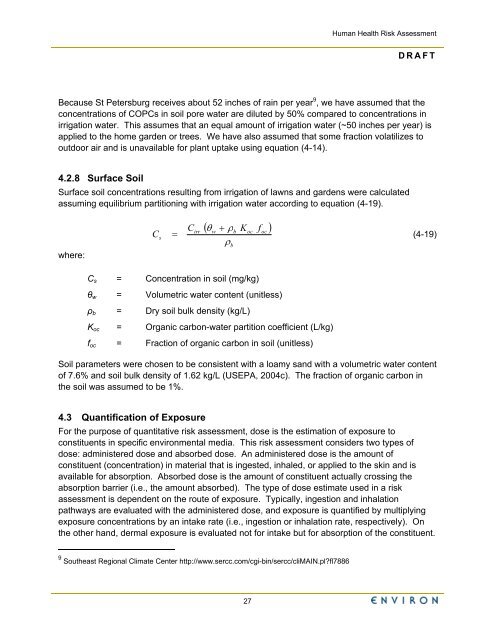Human Health Risk Assessment - Raytheon
Human Health Risk Assessment - Raytheon
Human Health Risk Assessment - Raytheon
Create successful ePaper yourself
Turn your PDF publications into a flip-book with our unique Google optimized e-Paper software.
27<br />
<strong>Human</strong> <strong>Health</strong> <strong>Risk</strong> <strong>Assessment</strong><br />
DRAFT<br />
Because St Petersburg receives about 52 inches of rain per year 9 , we have assumed that the<br />
concentrations of COPCs in soil pore water are diluted by 50% compared to concentrations in<br />
irrigation water. This assumes that an equal amount of irrigation water (~50 inches per year) is<br />
applied to the home garden or trees. We have also assumed that some fraction volatilizes to<br />
outdoor air and is unavailable for plant uptake using equation (4-14).<br />
4.2.8 Surface Soil<br />
Surface soil concentrations resulting from irrigation of lawns and gardens were calculated<br />
assuming equilibrium partitioning with irrigation water according to equation (4-19).<br />
where:<br />
C<br />
s<br />
C<br />
( θ + ρ K f )<br />
irr w b oc oc<br />
= (4-19)<br />
ρb<br />
Cs = Concentration in soil (mg/kg)<br />
θw = Volumetric water content (unitless)<br />
ρb = Dry soil bulk density (kg/L)<br />
Koc = Organic carbon-water partition coefficient (L/kg)<br />
foc = Fraction of organic carbon in soil (unitless)<br />
Soil parameters were chosen to be consistent with a loamy sand with a volumetric water content<br />
of 7.6% and soil bulk density of 1.62 kg/L (USEPA, 2004c). The fraction of organic carbon in<br />
the soil was assumed to be 1%.<br />
4.3 Quantification of Exposure<br />
For the purpose of quantitative risk assessment, dose is the estimation of exposure to<br />
constituents in specific environmental media. This risk assessment considers two types of<br />
dose: administered dose and absorbed dose. An administered dose is the amount of<br />
constituent (concentration) in material that is ingested, inhaled, or applied to the skin and is<br />
available for absorption. Absorbed dose is the amount of constituent actually crossing the<br />
absorption barrier (i.e., the amount absorbed). The type of dose estimate used in a risk<br />
assessment is dependent on the route of exposure. Typically, ingestion and inhalation<br />
pathways are evaluated with the administered dose, and exposure is quantified by multiplying<br />
exposure concentrations by an intake rate (i.e., ingestion or inhalation rate, respectively). On<br />
the other hand, dermal exposure is evaluated not for intake but for absorption of the constituent.<br />
9 Southeast Regional Climate Center http://www.sercc.com/cgi-bin/sercc/cliMAIN.pl?fl7886

















